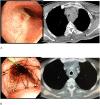Indications of airway stenting for severe central airway obstruction due to advanced cancer
- PMID: 28651011
- PMCID: PMC5484493
- DOI: 10.1371/journal.pone.0179795
Indications of airway stenting for severe central airway obstruction due to advanced cancer
Abstract
Background: Management of severe central airway obstruction due to advanced cancer is a medical and technical challenge. The impact of airway stenting on the clinical outcome of such patients is unclear.
Method: This single-center, retrospective study evaluated 21 patients who underwent airway stenting for advanced cancer. We examined predictors of the post-stenting mortality, including age, serum albumin, tracheal diameter, smoking, opioid use, respiratory failure, and performance status (PS). We also compared survival according to the PS.
Results: The mean survival period after stenting was 85.2 days. On univariate analysis, age, albumin, PS before airway stenting, respiratory failure, admission route, and PS grade were the candidates as possible predictors of prognosis after the procedure. On multivariate analysis, PS before airway stenting was identified as possible predictor of prognosis after stenting (HR 1.6180, 95% CI 0.969 to 2.7015, p = 0.066). The mean survival period after stenting was significantly longer in the good PS group, compared to the poor PS group (147.8 days vs. 38.2 days,p = 0.0346).
Conclusion: Airway stenting for advanced cancer may be more effective for patients in good general condition than in those with poor performance status.
Conflict of interest statement
Figures
References
-
- Wood Douglas E, Liu Yun-Hen, Vallieres Eric. Airway Stenting for Malignant and Benign Tracheobronchial Stenosis. Annals of Thoracic Surgery. 2003;76:167–174. - PubMed
-
- Bolliger CT, Mathur PN, Beamls JF. ERS/ATS statement on intervenetional pulmonology. Eur Respir J. 2002;19:356 - PubMed
-
- Ernest A, Silvestri GA, Johnstone D. Interventional pulmonary procedures. Guidelines from the American College of Chest Physicians. Chest. 2003;123:1693 - PubMed
-
- Matsuo Keisuke, Watanabe Yoichi, Tamaoki Akihiko. Indispensable Guideline for Airway Stent. The Journal of the Japan Society for Respiratory Endoscopy.2009;29: 26–9.
-
- Ettinger David S, Wood Douglas E., Akerley Wallace, Bazhenova Lyudmila A., Borghaei Hossein, Camidge David Ross et al. National Comprehensive Cancer Network(NCCN) Guidelines Non-Small Cell Lung Cancer Version 7. 2015:32–33
MeSH terms
LinkOut - more resources
Full Text Sources
Other Literature Sources
Medical


